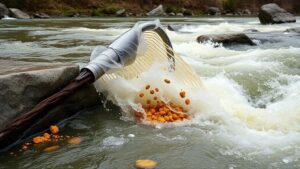The History of Ore Washing Troughs in Ancient Mining Communities
The History of Ore Washing Troughs in Ancient Mining Communities
The process of ore washing has played a pivotal role in the extraction and preparation of valuable minerals since ancient times. Within this context, ore washing troughs emerged as significant technological innovations that enabled mining communities to enhance their efficiency in separating valuable metals from waste rock. This article explores the history and development of ore washing troughs, examining their construction, utilization, and impact on ancient mining practices.
Origins of Ore Washing Techniques
The practice of ore washing can be traced back to several ancient civilizations, most notably the Egyptians, Romans, and Chinese. Initially, early miners separated ores from their surrounding materials using simple methods such as manual sorting and panning.
- The Egyptians utilized simple hand tools and gravity to wash gold from riverbeds around 3000 BCE.
- Roman miners perfected the technique of using sluices to channel water over crushed ore, allowing heavier mineral particles to settle.
These primitive methods laid the groundwork for more sophisticated developments, including ore washing troughs. The advancement was borne out of necessity, as high demand for metals such as gold, silver, and copper drove miners to innovate their extraction processes.
Construction of Ore Washing Troughs
Ore washing troughs, also known as troughs or sluices, were constructed from a variety of materials, including wood, stone, and later, metal. Their design typically featured a sloped channel, allowing water to flow over the ore and segregate heavier minerals by density. concept was akin to a water slide: as the water cascaded down, it would carry lighter debris away while retaining denser particles.
A notable example of this can be seen in the ancient Roman mining community of Las Medulas in Spain. The Romans built extensive networks of aqueducts to deliver water to gravel-filled troughs, enabling them to wash away the wash dirt and extract gold effectively.
Operational Mechanisms and Innovations
The operational mechanisms behind ore washing troughs relied heavily on gravity and water flow. Different designs evolved to enhance efficiency. Key innovations included:
- Hopper Design: Early troughs featured a simple opening at the top where ore was introduced. Over time, hoppers with higher sides were integrated to reduce spillage.
- Riffles: The introduction of riffles–small barriers along the bottom of the trough–captured heavier materials while allowing lighter waste to flow past.
Real-world applications of these mechanisms enabled ancient communities to significantly increase their yield. For example, a study of ancient mining sites in the Iberian Peninsula revealed that communities employing efficient ore washing systems could enhance gold recovery rates by up to 30% compared to earlier manual methods.
Cultural and Economic Impact
The introduction and advancement of ore washing troughs had profound implications for mining communities. Economically, the ability to effectively separate ore from waste facilitated increased productivity, leading to greater wealth accumulation. This wealth often translated into further investments in infrastructure, trade, and even military endeavors.
- In ancient Rome, increased gold production from mining activities contributed to funding massive construction projects, such as the Colosseum.
- The success of mining communities in regions like the British Isles significantly influenced local economies, establishing trade routes centered around the exchange of metals.
Conclusion and Lessons Learned
The development of ore washing troughs represents a significant milestone in the history of mining technology. By improving the efficiency of mineral separation processes, these innovations not only boosted economic prosperity but also fostered societal advancement across various civilizations. Understanding the historical context and technological evolution of ore washing troughs can provide modern societies with valuable insights into the importance of sustainable extraction practices and resource management.
As we consider the future of mining industries facing challenges such as resource depletion and environmental concerns, the lessons learned from ancient practices hold relevance. Innovations must continue to evolve, ensuring that mining remains viable while prioritizing ecological stewardship.


